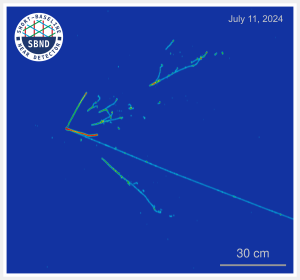Project summary: Wolfgang Pauli famously said, “I have done a terrible thing, I have postulated a particle that cannot be detected,” when he first proposed the existence of a very light, weakly interacting, neutral particle in 1930. These elusive particles, which we now call neutrinos, have continued to puzzle physicists ever since, raising a number of fundamental questions: Why are they so much lighter than all the other particles? Exactly how light are they? How many types of neutrinos exist? Are they their own antiparticles?
Nearly a century later, we have made remarkable progress in producing and detecting neutrinos at high rates in accelerator laboratories. The Short-Baseline Near Detector at Fermilab, for instance, records around 7,000 neutrino interactions per day in great detail. The image below is one such example, showing various types of particle tracks — muons, photons, pions, and protons, each color-coded by how quickly they lose energy inside the detector. However, the neutrino itself remains invisible, and we can only infer its presence from the visible particles that it produces.
To study neutrinos, we need to reconstruct their properties, such as cross sections, from what we can directly observe in detectors. This requires understanding both the neutrino source, like an accelerator, and how neutrinos interact with detector materials, typically heavy nuclei. Unlike the more widely used charged particle beams, which can be precisely controlled using electromagnetic forces, neutrino beams are neutral and much harder to manipulate, leading to larger uncertainties. Additionally, modeling neutrino interactions with nuclei is inherently complex due to the intricate nature of the nuclear structure. The interplay of these uncertainties, like how the interactions depend on neutrino energy, further complicates the challenge.
Modern accelerator neutrino experiments sit at the intersection of experiment and theory, as well as particle and nuclear physics. We now have advanced detectors capable of making precise measurements of particles that were once thought impossible to even detect. However, fully unlocking the potential of these experiments requires overcoming significant challenges in our understanding of neutrino-nucleus interactions. My research focuses on making high-precision measurements of data samples that are the most sensitive to specific interaction processes and nuclear effects, and using them to evaluate and enhance existing interaction models. These advancements will play a crucial role in bridging the gap between particle and nuclear physics as we enter a new era of precision in neutrino physics.



